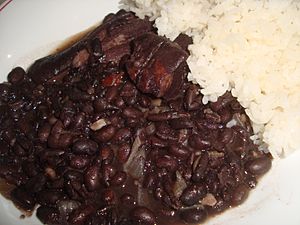Moros y Cristianos (dish) facts for kids
Moros y Cristianos is a yummy and traditional dish from Cuba. You can find it served in homes and restaurants all over the island! It's Cuba's special way of making rice and beans. This type of dish is popular in many places, like Latin America, the Caribbean, and even the Southern United States.
Contents
What Does "Moros y Cristianos" Mean?
The name Moros y Cristianos means 'Moors and Christians' in Spanish. It's a cool way to describe the two main parts of the dish.
The Meaning of "Moros" and "Cristianos"
In this dish, the dark black beans are called "Moros." The bright white rice is called "Cristianos."
A Bit of History in the Name
The name of the dish comes from a long time ago in Spain. From the early 700s, a group called the Moors (who were Muslims from Africa) ruled parts of Spain. Later, in the 1400s, Spanish Christians took back control of the land. The dish's name is a fun way to remember these two important groups from history.
How to Make Moros y Cristianos
Making this dish involves cooking the beans and rice together in one pot. This helps all the flavors mix perfectly!
Starting with Sofrito
First, cooks often make a special flavor base called a sofrito. This is usually made by cooking chopped onions, garlic, and bell peppers. It gives the dish a wonderful smell and taste.
Cooking the Beans and Rice
After the sofrito is ready, white rice and black beans are added. The beans are usually boiled beforehand. The water used to boil the beans is also added to the pot. This water has lots of bean flavor!
Adding More Flavor
Other spices are often put into the dish. Things like oregano and bay leaf can make the Moros y Cristianos taste even better.
Moros y Cristianos vs. Other Dishes
Moros y Cristianos is special because the beans and rice cook together. This is different from a simple arroz con frijoles, where the rice and beans are cooked separately.
Understanding "Congrí"
Sometimes, people use the word Congrí for this dish too. However, Congrí often refers to a similar dish made with red beans. This red bean version is more common in the eastern part of Cuba.
See also
 In Spanish: Moros y cristianos (gastronomía) para niños
In Spanish: Moros y cristianos (gastronomía) para niños


